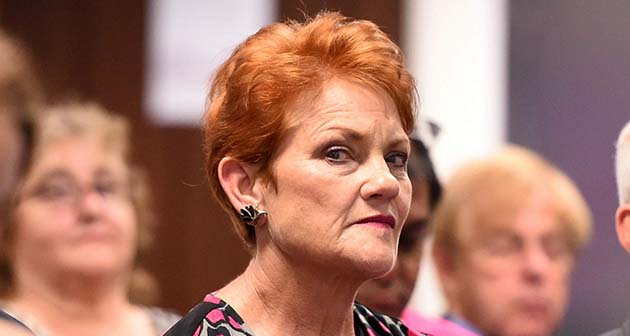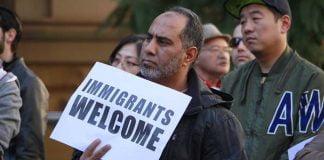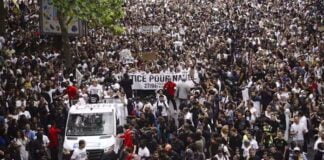In 2016, Pauline Hanson made her way back into parliament for the first time since 1998, obtaining 9 per cent of the Senate vote in Queensland. Despite her many electoral defeats over this time, the racism at the core of Hanson’s politics has never gone away. Instead it has become part of mainstream politics.
In the latest Quarterly Essay, David Marr details the progression of Hanson and how the major parties have come to not only accommodate her racism, but also adopt her policies.
Marr makes clear that Hanson’s ideas should be called for what they are—racist. When she first entered the political stage in the late 1990s, Hanson attempted to whip up hysteria about Asians and Aboriginal people. More recently, she has turned her attention to Muslims. She has called for surveillance cameras in mosques and wants to ban halal certification and all Islamic head coverings.
Yet Islamophobia has become so normalised that Hanson’s policies no longer cause the same level of outrage. Marr writes, “These days she seems hardly even a surprise. She was such big news in Asia the first time around that the Foreign Press Association declared her the most famous Australian in the world. These days she makes no headlines offshore.”
He rightly pins the blame for this squarely on the mainstream parties, pointing out, “neither Coalition nor Labor leader will bluntly call Hanson on race”.
While globally there has been a growth in far-right, racist parties, Marr notes that Hanson’s following is not yet on the same scale as that of her overseas counterparts, such as Marine Le Pen, Nigel Farage, or Trump. Australia was not hit as hard by the financial crisis as Europe and America. Marr points to the 2016 Scanlon survey results to show that 70 per cent of Australians are happy with current immigration levels or think they should be increased.
Yet disillusionment with mainstream politics here is still clear—just 26 per cent believe governments can be trusted.
Who Votes One Nation?
Marr uses data from the 2016 Australian Election Study, compiled by academics at the ANU, to examine where One Nation’s support comes from. Its voters are almost as likely to be found on the fringes of cities as they are in rural areas.
Many people are disillusioned with politicians, but One Nation voters are furious, seeing them as only looking after themselves. They also mostly think that the economy and their own financial situation is getting worse, despite the fact they overwhelmingly have jobs and are “middling prosperous”.
In 1998, Hanson won 53 per cent of her votes from people who previously voted for the Coalition. In 2016, she took an even share of 39 per cent each from Labor and Liberal.
But what is most distinctive, he argues, is that over 80 per cent of them want immigration numbers cut.
Embracing Hanson’s Racism
Rather than take a principled stand against Hanson’s racism, the major parties have adopted her policies in efforts to win back the votes, and have themselves used migrants as a scapegoat for economic problems.
In the lead-up to the 1998 Federal election, Howard tried to out-do Hanson. Marr writes, “He slashed funding to Indigenous people, cut immigration numbers, tightly restricted family reunion visas, cut welfare for migrants, tried his best to neuter native title and closed Australia to boat people. Hanson had called for each of these policies.”
Hanson lost her seat and One Nation won only a single Senator following the Liberal Party’s decision to put One Nation last, but Howard continued to adopt her policies. In 1999, Howard teamed up with Labor’s Kim Beazley to introduce the punitive temporary visa for refugees—a policy Hanson had first floated in 1998.
Hanson went on to campaign in the 2001 state elections for a blockade of refugees coming by boat. It became a reality when the Howard government that same year ordered refugees rescued by the Tampa to be sent to Nauru.
With the help of the Labor Party, John Howard made her ideas mainstream.
The same strategy has been used by the major parties ever since. From Gillard’s re-introduction of offshore processing of refugees, to Abbott’s explicit Islamophobia, reflected in his statement, “I’ve often heard Western leaders describe Islam as a religion of peace. I wish more Muslim leaders would say that more often, and mean it.”
Most recently Turnbull has attacked migrants through changes to the 457 visa and citizenship process.
Hanson’s supporters remain a small core, but the scapegoating of migrants and refugees by the major parties has had an effect. The Scanlon survey showed that 61 per cent of Australians disapprove of asylum seekers attempting to reach Australia by boat. It also found that discrimination and abuse experienced by migrants has increased.
While Marr’s essay is a must-read for understanding racism in Australia today, one thing lacking is a discussion of how to confront the racism.
The persistent work of activist groups like the Refugee Action Collectives show that grassroots activism can work to swing public opinion. This same thing is true when it comes to confronting the racism being whipped up by Hanson and the major parties.
By Vivian Honan
The White Queen: One Nation and the Politics of Race
By David Marr
Quarterly Essay 65






